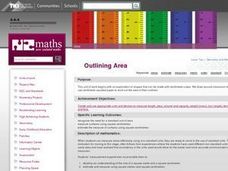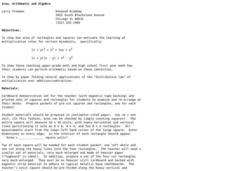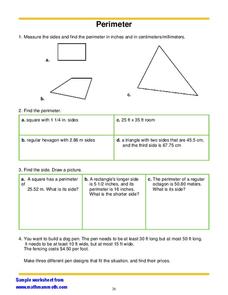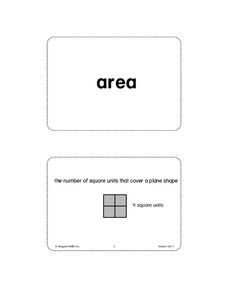Savvas Learning
Area of Squares and Rectangles, Alternative Lesson
Find the area of squares and rectangles and discuss square inches and square centimeters with your young geometers. Follow the example provided, and then let learners try it for themselves! They will find the area of seven rectangles.
Curated OER
Outlining Area
Explore measuring various objects using square centimeters. Learners create various shapes using five centimeter cubes, calculate the area in square centimeters of different classroom objects, and discover who has the largest mouth,...
Curated OER
Area and Volume
What is the difference between area and volume? Have your charges build models of square centimeters, square inches, square feet, square meters, etc. It's definitely challenging, but there is no better way to learn than by trying...
Math Worksheets Land
Measure Area by Counting Units - Step-by-Step Lesson
What is the area? Because there is only one problem here with a detailed explanation below, consider projecting this as an all-class warm up. Learners examine a rectangle split into 12 squares. They know that each unit is three...
Math Worksheets Land
Measure Area by Counting Units - Guided Lesson
Given measurement information on individual squares within a larger shape, scholars determine the total area of that square or rectangle. For one of these three problems they draw the shape knowing its total area and the measurements of...
Curated OER
Surface Area and Volume of Cubes
In this surface area and volume worksheet, 10th graders identify and complete 3 different problems that include determining the surface area and volume of cubes. First, they use their ruler to find the width and height of each cube....
Curated OER
Square Numbers
Fourth graders demonstrate multiple ways to represent whole numbers, decimals, and fractions. Through demonstration and hands-on activities they model square numbers using arrays. Students visually determine that the array makes a square.
Common Core Sheets
Finding Area
Practice makes proficient! Here, 10 versions make up an area worksheet in which mathematicians find the area rectangles and squares in centimeters.
Curated OER
Measure Area by Counting
If each square has sides measuring two centimeters, what is the area of this shape? Learners find area in five shapes segmented into squares with given sides. Encourage them to use square units in their answers. Next, they do the...
Curated OER
Learning by Logic - Total Surface Area
Geometers calculate the area of plane surfaces using the formulas for the area of a square, rectangle, and triangle. They develop the formula for calculating the total surface area of two geometric solids: the cube and rectangular prism.
Curated OER
Area, Arithmetic and Algebra
Explore the concept of this perfect square trinomial and difference of squares lesson. A hands-on activity that uses paper rectangles and squares to illustrate the perfect-square trinomial and difference of squares formulas.
Curated OER
Morning Math
Good morning, math scholars! There are 10 warm-ups here to get your class recalling past concepts and staying sharp on newer ones. Skills include writing an even and odd number sequence, subtracting money amounts, dividing shapes in...
Curated OER
Playground Measurement
Fifth graders find a rectangular or square object in the classroom to measure. They measure to the nearest centimeter and apply that knowledge to measuring perimeter. They recognize, describe, and determine surface area and volume of...
Curated OER
Shape Picture
Get your youngsters using rules! For this challenge, they measure the shapes that make up a house and a tree to practice measuring in centimeters. Then, they write down the equation for each shape. (Example: 4+6+4+6.) Finally, they...
Curated OER
Perimeter
For this perimeter worksheet, students measure the sides of three triangles to find the perimeter in inches and centimeters. Students find the perimeter of a given square and hexagon as well.
Houghton Mifflin Harcourt
Unit 7 Math Vocabulary Cards (Grade 2)
Reinforce math vocabulary instruction with a set of flash cards. Fifty-six cards offer either a bold-face word or a picture representation equipped with descriptive labels. Terms include centimeters, gallons, square units, and more!
Utah Education Network (UEN)
The Pasture and the Fence
Beginning geometers use tiles and grid paper to draw and calculate perimeter and area. Rectangles of different sizes are created and then measured to build understanding. The one-inch grid sheet referenced is attached.
Curated OER
Grade 3: What Can I Make with 30 Centimeters?
Third graders create polygons with perimeters of 30 centimeters, use the centimeter grid paper to determine the area of each shape, and organize the shapes to make generalizations from the patterns they see.
Curated OER
Perimeter and Area
In this measurement instructional activity, 6th graders calculate the perimeter and area for 9 different squares. Students record their answers on the lines beneath each square.
Curated OER
The Square Counting Shortcut
An excellent lesson that encourages students to discover how complex figures can be broken into simpler shapes when measuring area. Working with block letters, learners are given the freedom to develop their own strategies for...
Curated OER
What a Square
Students examine the painting "Old Man With A Gold Chain" by Rembrandt. They identify geometric shapes in the painting, measure these shapes and compare the relationships of these measurements.
Curated OER
It Takes Ten
Review and use standard units of measure with your math class. They move from station to station estimating and measuring length, volume, weight, and area. At each station they estimate and measure, and then compute the difference...
PBS
Frame Yourself: Area and Perimeter
Elementary schoolers are arranged in pairs and view the video Math Works: Measurement: The Difference Between Perimeter and Area. They discuss any prior knowledge they have of the term perimeter and then brainstorm together what the...
Curated OER
How much room?
Students examine the amount of usable space that exists in their classroom using square meters and square centimeters. They apply the information to predict the ideal size of a classroom.

























